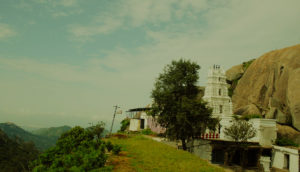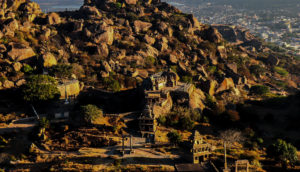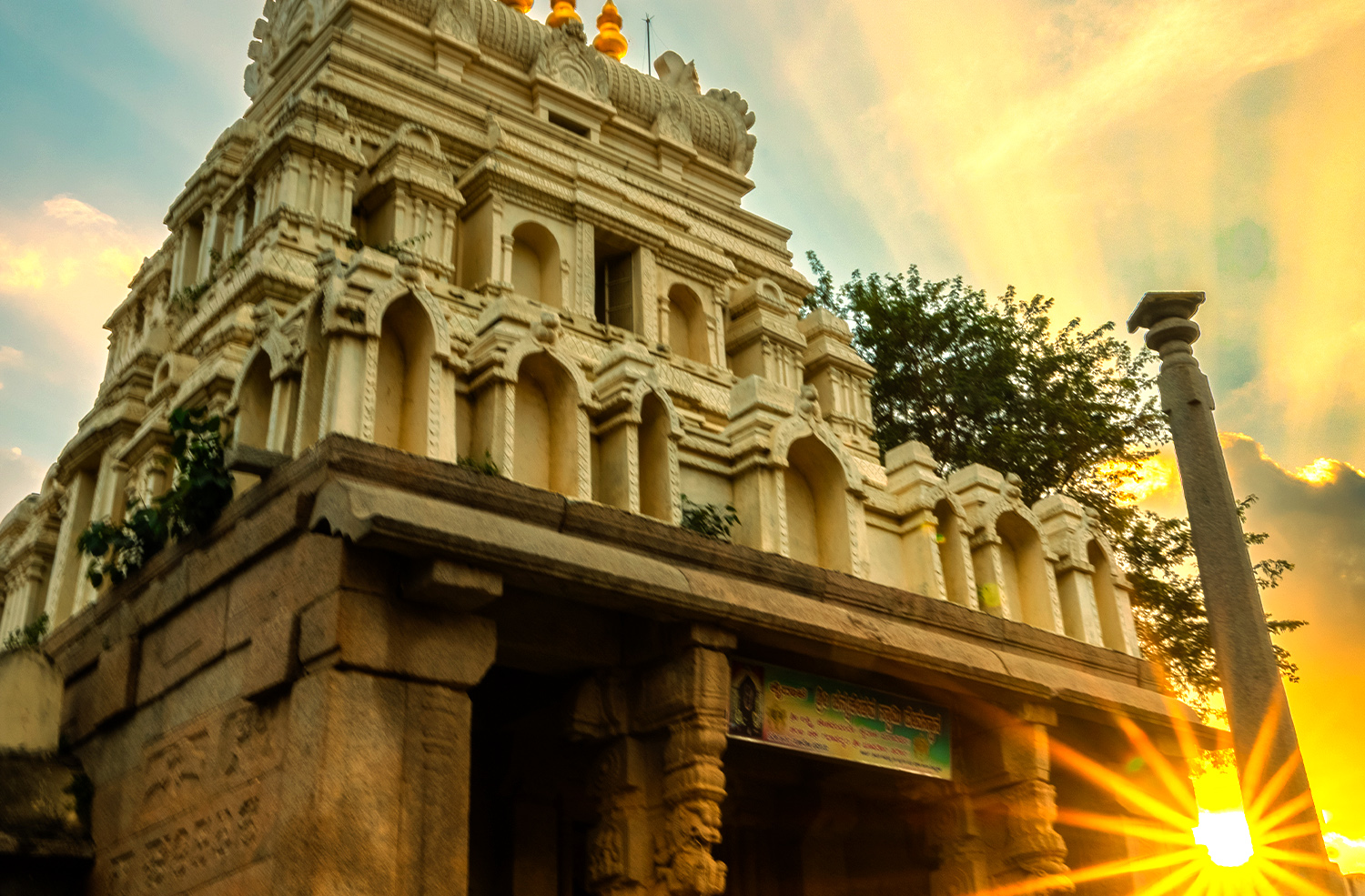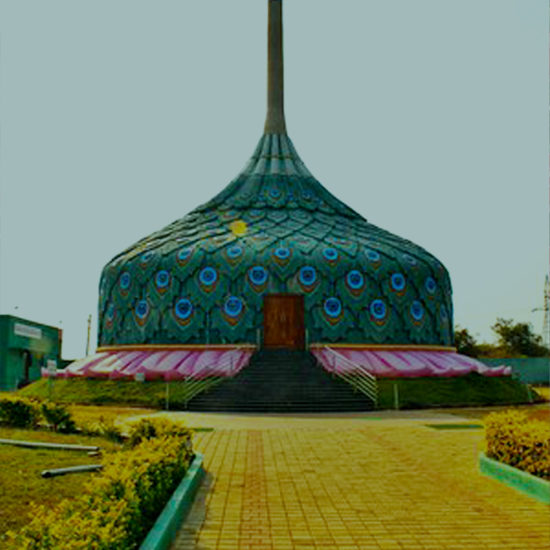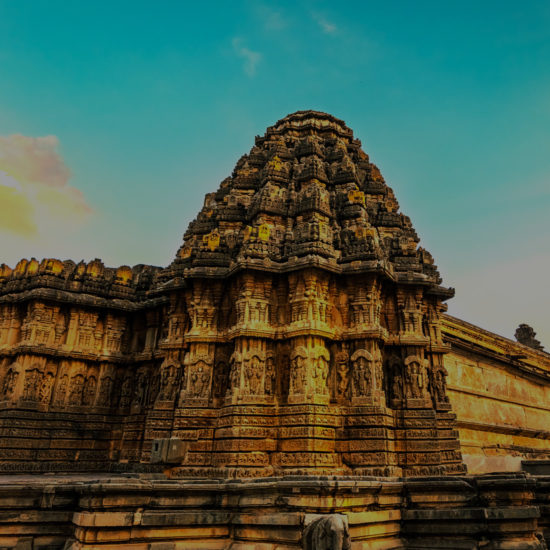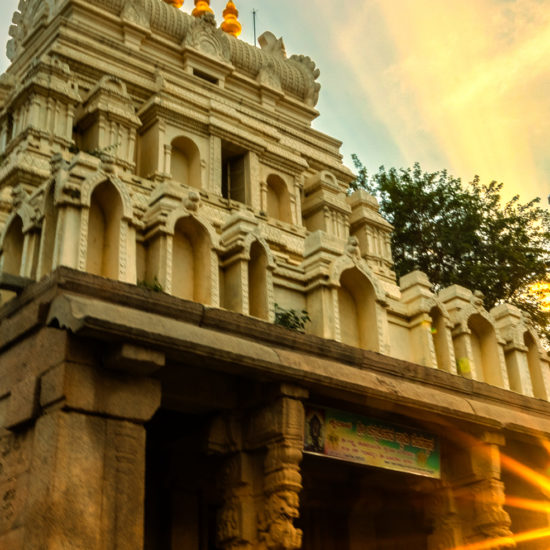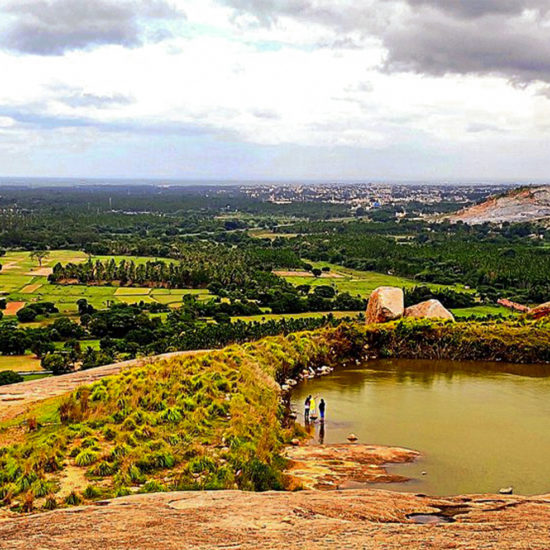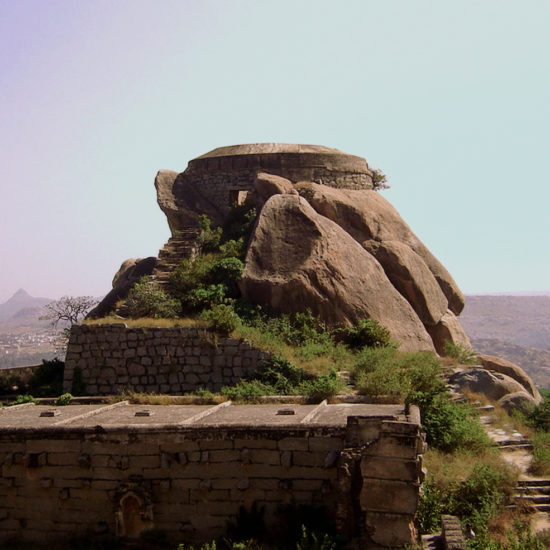Located around 65 km from Bengaluru, Tumakuru is the second-largest district in the state of Karnataka. Tumakuru district shares its border with eight districts, which is the highest in the state; Chitradurga towards the north, Hassan and Chikkamagaluru towards west, Mandya towards the south-west, Ramanagara and Bengaluru Rural towards the south, Chikkaballapura towards east and Ananthapuram (Andhra Pradesh) towards north-east. The earliest recorded history of Tumakuru dates back to around 400 AD with the discovery of copper plates of the Ganga Dynasty. Also known as ‘Kalpataru Nadu’ (land of coconuts), the district is known for the production of coconuts. It is also a major education hub; home to Tumkur University and many colleges including medical, engineering, dental, degree and postgraduate colleges and many polytechnics. It is also home to India Food Park which is one of the Mega Food Parks in India with fully developed plots for entrepreneurs to set up food processing units.
For further information, visit the official district website click here!
Tourist Attractions
- Markonahalli: Markonahalli Dam is a dam built across the Shimsha River in the Kunigal Taluk. It was built by Krishnaraja Wadiyar IV, the King of Mysuru under the guidance of his Diwan Bharat Ratna Sir M. Visvesvaraya. This project is very unique because of the technology that is used. This was arguably the first dam to get built using the Siphon system. Here, siphons are installed designed in such a way that when the dam reaches its maximum capacity, these siphons naturally allow water to pass through the gates. Unlike other dams where the gates are always closed to stop the flow of water, here at Markonahalli the gates are always open and the water doesn’t flow unless the dam is full. This dam uses the principle of air flow and is truly an example of quality engineering of that time and the genius of Bharat Ratna Sir M. Visvesvaraya who is regarded as the architect of modern Karnataka.
- Pavagada: Pavagada is a taluk headquarter known for popular Pavagada Fort. Pavagada Fort is at a height of 700 meters, offered seven layers of fortification to its residents and was built by the Vijayanagara rulers in the 14th Trek to the top of Pavagada hill to visit the fort may take up to 2 hours. Resting places are available on the way up, cool breeze will offer some respite in otherwise usually hot weather. A Hanuman temple is located halfway uphill. Essentials like water, fruits and food are available at shops near the foot of the hill. Shani Mahatma temple is located at the foot of Pavagada hill. Pavagada gets huge crowd of visitors during Shravana Masa (July-August)
- Madhugiri Fort: Madhugiri is a single hill and believed to be the second largest monolith in Asia. Madhugiri Fort is built on the top, perched on a steep slope of the hill. It is also a sought after one-day trekking trip from Bengaluru city, and easily accessible including by public transport. The trek here is between moderate to difficult given the steep climb. However, there are sidebars and iron rods to help you navigate your way up the hillside.
- Jayamangali Blackbuck Reserve: An open area home to blackbucks that roam freely in an open area bordering Andhra Pradesh.
- Borana Kanive: A fine picnic spot next to a reservoir built across Suvarnamukhi River.
- Devarayana Durga: In the hilly terrain of Devarayanadurga, are various holy spots like the temples dedicated to Yoga Lakshmi Narasimha Swamy, Bhoga Narasimha Swamy and the Sanjivaraya Temple dedicated to Lord Hanuman. Near the Narasimha Temple are three sacred ponds called Narasimha Teertha, Parashara Teertha and the Pada Teertha. The Pada Teertha is inside a large cave. There is another cave with the statues of Lord Rama, his consort Sita and his brother Lakshmana. The rivers Jayamangali and the Shimsha originate from these hill ranges. Explore Devarayanadurga, and get your adrenaline pumping as Devarayanadurga is an ideal spot for trekking. Get a stunning panoramic view of Tumakuru from atop the Devarayanadurga hill.
- Namada Chilume: Located near to Devarayanadurga hill, is Namada Chilume, a historical place which has a small stream of water flowing throughout the year. Legend has it that this streak of water is flowing since the Thretha Yuga and is believed to been created by Lord Rama. It is said that Lord Rama had shot an arrow to get water during the Vanavasa period and it is believed to have never dried up since. The source of spring is unknown till today. Nearby, it has small forest and a beautiful Deer park as well.
- Huliyur Durga: Home to an old fort built by Kempegowda. Fort is 2771 feet above sea level and houses a granary, barracks, weapon storage units and other facilities.
- Hutridurga: A fortified hill 3808 feet above sea level with a Shankareshvara temple on the top.
- Chennairayana Durga: A hill 3734 feet above sea level, with an old fort, tank and Ishvara temples
- Sira: Sira town and fort was founded by Rangappa Nayaka. Sira was later conquered by Ranadulla Khan, a general in the Bijapur Present day Sira has the Juma Masjid and the tomb of Malik Rihan, ruins of a palace, fine garden and Ibrahim Rauza, a complex of tombs with the look of Hindu monument.
- Kandikere: Home to a ruined fort and Gopalakrishna temple
- Midigeshi: Hoe to a wonderful hill fort and Venkataramana temple
- Nagalapura: Home to Chennakeshava temple and Kedareshwara temple
- Nidugal: A fortified hill 3769 meters above sea level
- Nittur: Referred to as Aihole of South, Nittur is a place of historic importance, with temples of Padmavati, Mariyamma and several Jain temples
- Nonavinakere: Home to Gopalaswamy temple, Beterayaswamy temple and Garigeshvara temples. Nonavinakere was a prominent centre during the Nolamba
- Theeta Reservoir: A lake and picnic area 30 kms from Tumakuru
Religious Places
- Siddhaganga: Siddhaganga, a famous pilgrim centre, has a hilltop temple dedicated to Lord Siddhalingeshwara. At the entrance of this temple, six shrines can be seen. The Veerashaiva Math, an important educational and pilgrim centre, is close by. The Matha feeds thousands of students and pilgrims daily. This is one of the important educational centres.
- Sri Siddaganga Math: Sri Siddaganga Math was established by Sri Gosala Siddeshwara Swamiji in the 14th century AD. The highly progressive history of Sree Siddaganga Math, especially in the last two centuries can be attributed to the dedication, knowledge and wisdom of two of its greatest religious leaders namely Sri Sri Uddana Shivayogiglu and His Holiness Dr. Sri Sri Sivakumara Swamigalu who, in fact was popularly called as Walking God and was highly respected by people of all religions. The Math established Sri Siddaganga Education Society in 1963 & runs more than 128 educational institutions. It also provides education to more than 10,000 poor children with free food and shelter, without any discrimination of caste or creed. The Math also runs blind schools at various places & over 100 blind children are given free education & food with independent hostel facilities.
- Lakshmikantaswamy: Largest and oldest temple in Tumakuru town.
- Amruthur: Home to Chennakeshava temple and Pattaladamma temple
- Bhasmangi: A fortified hill with Bhasmangeshwara temple, 42 kms from Tumakuru. Bhasmangi also has a palace built by Hyder Ali on top of the hill and perennial supply of water.
- Aralaguppe: 6 km from Banasandra railway station, famous for the 9th century Kalleshwara temple built in Ganga-Nolamba style. Ceiling of Kalleshwara temple features a wonderful dancing Shiva sculpture with musical accompanists and eight Dikpalas (guards) surrounding him with all their paraphernalia. Aralaguppe is also home to Chennakeshava temple built in Hoysala style. The image of Vishnu in the inner sanctum is magnificent. There are four Ganga temples in Aralaguppe.
- Goravanahalli Mahalakshmi Temple: About 30 km from Tumakuru in Koratagere taluk is the Goravanahalli Mahalakshmi Temple. The Deity worshipped here is Goddess Mahalakshmi which is a Swayambhu (self-manifested). Special poojas are performed on Fridays and it is believed that by performing pooja here, a devotee's financial problems will get solved. The temple features a large, multicolored Gopura with smaller arches on both sides. The temple also has verandahs on either side.
- Chennakeshava Temple, Kaidala: It is believed that this temple was built by the father son sculptor duo of Jakanachari and Dankachari. It is believed that Jakanachari was the master sculptor who built the world famous Belur Chennakeshava Temple. However, this temple at Kaidala lacks the magnificence of the Belur Chennakeshava Temple but the idol of the deity is almost the same as the one in Belur. The 5 feet 6 inches tall deity of Lord Chennakeshava, in black stone is flanked by Sridevi and Bhoodevi. The pillars are beautifully carved with sculptures adorning them.An interesting legend is associated with this temple. Once, Jakanachari leaves behind his wife and unborn child to pursue his art and attain fame by building temples. Time passes and he builds numerous statues and temples. He reaches Belur wherein he agrees to sculpt the Chennakeshava Temple, which across time has now become one of the best specimens of Hoysala architecture. Meanwhile his son Dankanachari, now all grown up, leaves home in search of his father. Dankanachari reaches Belur and goes to inspect the sculptures. He points out a flaw in an idol in the temple. Angered, Jakanachari refuses to accept that there could be a blemish and vows that he will cut off his own hand if a flaw is found.Then the statue was covered with sandal paste which dried on every part except the navel area. Dankanachari picked a stick and poked it wherein they saw a frog sitting in the damp cavity. As vowed, Jakanachari cut his right hand. The statue became famous as ‘Kappe Channigaraya’ (Kappe means Frog in Kannada). Curious about this young man who had mastered such perfection in sculpting, Jakanachari enquired about him and to his great surprise, Jakanachari found that Dankanachari was his own son.Later, Jakanachari gets a vision to construct a Chennakeshava Temple at his home town, Kaidala. The father-son duo then move to Kaidala where it is said that Jakanachari got back his hand after he completed the temple construction (hence the name Kaidala (Kai means hand in Kannda). So, Jakanachari was reunited with his wife and son.
- Turuvekere: Turuvekere was once an ‘Agrahara’ (an area of land which was provided to scholarly brahmins priests) in the 13th century AD by the Hoysala kings. Turuvekere boasts of many fine Hoysala temples with the major attraction being the Chennakeshava Temple dedicated to Lord Vishnu. It is believed to be built by Mahadandanayaka Somanna who also built the famous Somnathpur Temple in Mysuru. The Gangadhareshwara Temple dedicated to Lord Shiva has a Shivalinga with serpent hoods carved in a single piece of stone and is considered an example of fine sculpting. This temple also has a finely sculpted Nandi (vehicle of Lord Shiva) statue which retains its shine even today. To the east of the Gangadhareshwara Temple is a large soapstone bell, which when tapped emits a metallic sound. The Moole Shankareshwara Temple, dedicated to Lord Shiva, is located here. Believed to be built in 1260 AD, the temple plan has a Bhumija Nagara (north Indian) style of architecture.
- Seebi: 24 kms from Tumakuru, Seebi is popular for Narasimha temple with interesting murals.
- Yadiyur: Yadiyur was the home of a popular Veerashaiva spiritual teacher and author, Totada Siddhalinga. Siddhalingeswara temple in Yadiyu, built in Dravidian style houses Samadhi of Todada Siddhalinga. Annual car festival of Siddhalingeswara temple takes place in March-April and lasts a fortnight. The procession car (ratha) is a majestic vehicle with six big stone wheels.
- Chikkanayakanahalli: Popular for Venkataramana temple, Renukadevi temple and two Anjaneya temples
- Gulur: Popular for a huge Ganesha idol made of clay each year.
- Holavanahalli: Houses tomb of Sri Raghavendraswamy in a Brindavana (garden).
- Hosahalli: Popular for its Kalleshvara temple
- Huliyar: Home to Ranganatha temple built in Hoysala style
- Kadaba: Home to Rama temple built in Dravidian style
- Kadasur: Home to Bhairava temple
- Keregodi: Home to Shankareshvara temple with a garden full of fruit bearing trees and flower plants.
- Koratagere: Home to temple of Sri Gangadhareshvara in a cave.
- Kunigal: Home to Hoysala era Narasimha temple, Someshvara temple, Venkataramana temple, Shivarameshvara temple and Padmeshvara temple
- Siddarabetta: Home to Samadhi of Saint Gosala Siddheshvaraswamy, known for rocky hills, cave temples and a perennial spring.
- Tandaga: Home to 14th century Hoysala style Channakeshava temple.
- Turuvekere: Home to Basava temple, Gangadheeshvara Temple, Channgiaraya Temple and Shankareshvara temple.
- Vighnasante: Known for Lakshminarasimha temple and Balalingeshwara temple
Others
- Pavagada Solar Park: Pavagada Solar Park is the world largest solar park located in Pavagada taluk, Tumakuru spread over a total area of around 13,000 acres and commissioned in 2018. The project was developed by Karnataka Solar Power Development Corporation Limited (KSPDCL), a joint venture between Solar Energy Corporation of India (SECI) and Karnataka Renewable Energy Development Limited (KREDL). The total capacity of this park is 2,000 MW. A unique feature of this park is instead of acquiring land, KSPDL entered into a lease agreement with farmers/ landowners to obtain land on an annual rental basis. The project is part of Karnataka’s Solar Policy 2014-2021, which aims to shift the dependency from conventional power resources to eco-friendly energy resources.
- India Food Park: India Food Park is one of the Mega Food Parks in India. Mega Food Park is a scheme of the Ministry of Food Processing Industries, Government of India that aims at providing a mechanism to link agricultural production to the market by bringing together farmers, processors and retailers so as to ensure maximizing value addition, minimizing wastage, increasing farmers income and creating employment opportunities particularly in rural sector.
- Gubbi: Popular trading centre, educational hub and home to Gadde Malleshvara temple and Gubbi Chennabasaveshvara temple.
- Tipaturu: A popular trading center and home to several modern era temples.
Nature & Wildlife
- Kaggaladu Bird Sanctuary: A nondescript village in Tumakuru district wakes up each year to the raucous cries and colourful plumage of painted storks and grey herons, as they nest on old tamarind trees amidst the houses. The Kaggaladu Bird Sanctuary is said to be the second largest painted storks’ sanctuary in South Asia, after Kokrebellur Bird Sanctuary in Mandya district. From around January to August, Kaggaladu comes alive with bird cries, squawks and mighty wing flaps when countless painted storks and herons descend, for the breeding season apart from other birds. Every tree holds many nests, and if you go in May the sight in each tree with multiple nests is amazing. The storks are important to the villagers and are taken care like their own offspring. In order to preserve their natural habitat, tamarind trees are maintained for the birds to roost and nest on. Moreover, their droppings which is abundant in potassium and phosphate are used as manure for the villager’s crops. The birds live in perfect harmony and mutual tolerance with the local villagers, and enjoy their protection – a perfect example of peaceful co-existence between man and nature.
Tour Location
Tumakuru well connected by rail and road network from all over Karnataka.

Medium:
CNV Chambers
Naveen Regency
Vilasi Comforts




